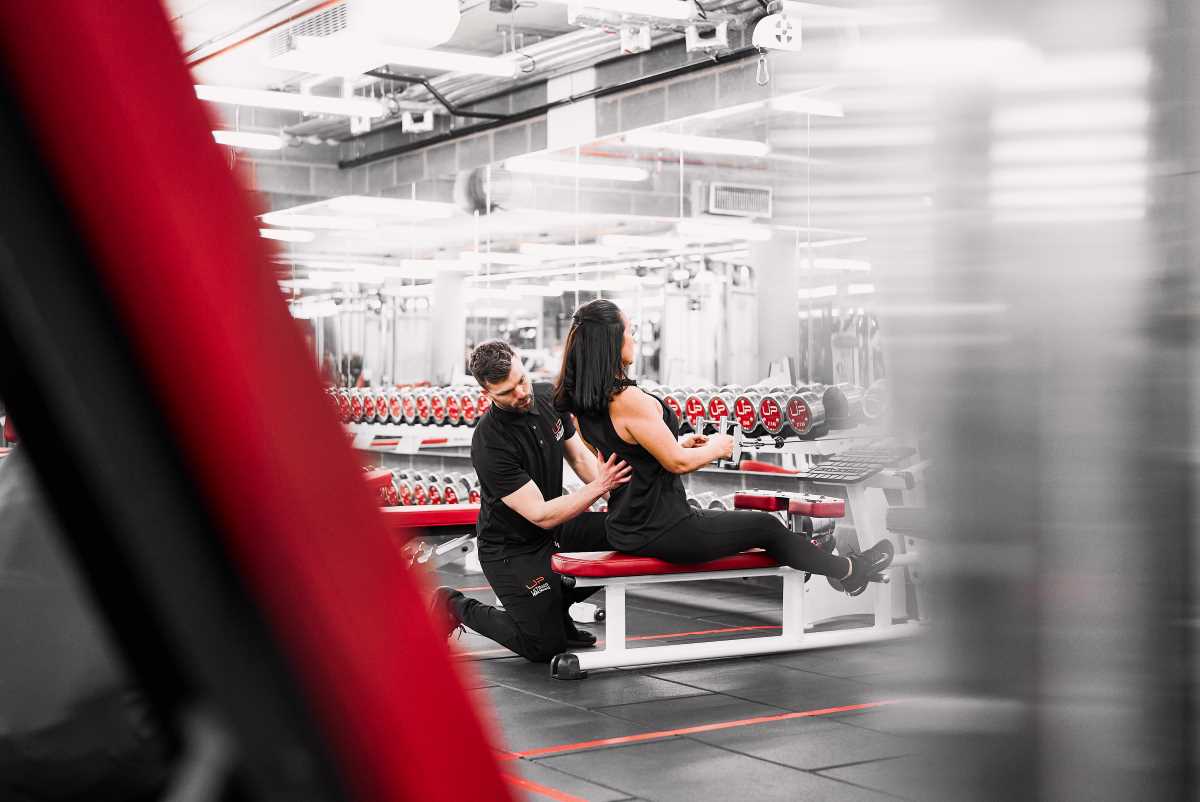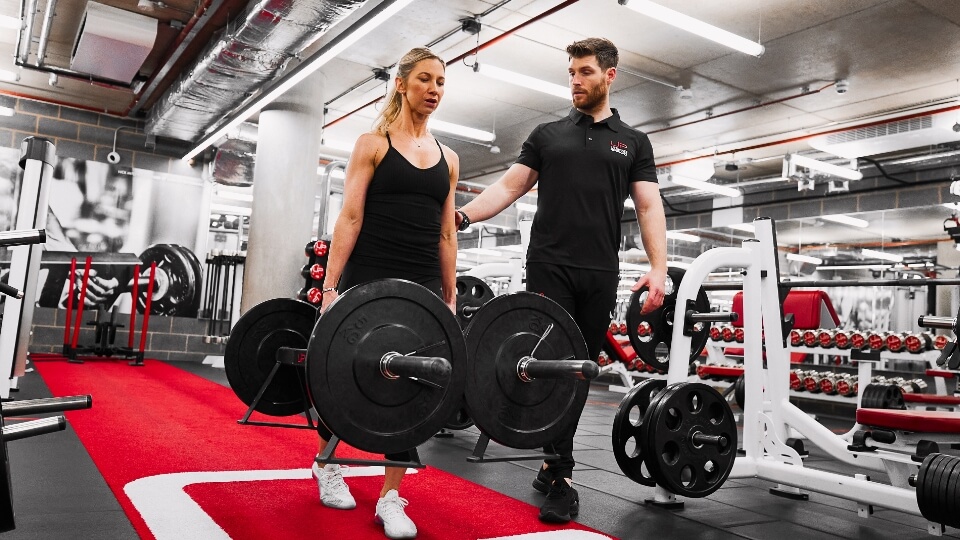There is a lot of conflicting information out there as to whether machines or free weights are best to help you achieve your fitness goals.
Many fitness experts pit machines and free weights against each other, but it doesn’t have to be an either-or situation. Your muscles only experience the force provided by machines and free weights, so they are equally effective for muscle growth in most cases.
Exercise selection will always be dependent on the individual depending on their exercise history, abilities and goals. Also, the execution of some exercises can vary from person to person depending on height, limb length, and torso length, impacting which muscles work harder than others.
For example, when performing a squat, the length of your thigh and shin bones will significantly influence how upright or bent over you become as you lower into the movement. You may need to modify the squat or choose an alternative exercise altogether, like a hack squat or leg press.
Does it have to be an either-or situation, or do free weights and machines both have their place? Let us explore this further.

What is the difference between free weights and machines?
Free weight exercises are those where the range of motion is unrestricted, and the movement requires a lot more stability. When performing a dumbbell chest press, you push the weight upwards, but you are also stopping it from falling sideways. Machines provide resistance through a fixed path of motion and are generally more stable than free weight exercises.
Which is better for muscle growth?
Research shows that when you lift weights, your body doesn’t know whether you are using a machine or free weights as it only experiences the resistance they provide and the tension your muscles generate to move the load. Therefore, both can apply similar amounts of stress to stimulate muscle growth [1].
Are free weights more functional?
Often people use the term ‘functional’ to mean that an exercise has more carry-over to the demands of daily living, such as chores or carrying things. Fortunately, movement does not have to mimic real-life to be functional, so there is no such thing as a ‘non-functional exercise. Simply becoming stronger is enough to improve [2].

What are the benefits of training with free weights?
While many fitness ‘experts’ set free weights and machine exercises against one another, they each have unique advantages that help you determine when and where to include them in your program.
Free weights have better carry over for the power lifts
The principle of specificity states that the most efficient route to improving strength in a specific movement is to train that movement. For example, if you have strength-based goals in the gym, like increasing how much load you can squat, you should prioritise squatting over other movements. This doesn’t mean you should only do these lifts, as many factors contribute to the loads you can lift, including muscle size, which you can increase through machine exercises.
Most free-weight exercises allow for more variation
While it’s not always the case, most free-weight exercises allow you to provide more variation to your training by manipulating factors like grip width, i.e. a close-grip bench press versus a conventional grip bench press. These variations allow you to alter your specific focus in an exercise purposefully. For example, during a close-grip bench press, your triceps must work harder than usual and, therefore, can help tone your arms more than a conventional bench press if that’s your goal.
Free weights are more practical if you train at home
Free weights are more practical in almost all situations if you’re training at home with limited space. You can perform a tonne of whole-body workouts with just a few pieces of kit, including a barbell, dumbbells, a rack, and a bench. In contrast, because machines lock you into a given range of motion and are generally less versatile, you would need multiple machines to allow you to train your whole body, which takes up more space and costs more on average.

Benefits of training with machines
Machine exercises are typically safer
Because machines require less skill and motor control than free-weight exercises, they’re typically safer than free weights and cause fewer accidents and injuries [10]. Equally, it is often safer to train closer to failure on machine exercises, as it is far less likely for your technique to break down and cause you to fail. This is beneficial because your muscles are more likely to fail than your technique, which is crucial for shaping your physique [11].
Machine exercises are more efficient for performing intensity techniques
Research shows that intensity techniques like rest-pause and drop sets are efficient for stimulating muscle growth. Machines may be more appropriate when performing these movements as these techniques require you to quickly reduce your working weight or put down and pick up implements relatively quickly. This is generally easier to do on machines, especially those that are pin loaded. In contrast, if you’re using a bench press or dumbbell press to do a drop set, for example, where you continue to lower the weight as you start to fatigue, it requires unracking and re-racking weights each time as well as setting yourself back up to perform the exercise. As a result, this costs extra time and is more fatiguing than simply changing the pin on a machine stack, leaving machine exercises more suited to the job.
Some machine exercises have better resistance profiles than free-weight exercises
A resistance profile essentially reflects which portion of a lift is most challenging and which is easiest, or in which portion you need to exert the most and least force. For example, during a barbell Romanian deadlift, the exercise is ‘harder’ at the bottom and ‘easier’ as you reach the top. This is important because some machines have resistance profiles that match where you’re physically stronger or weaker in a lift, which research shows can be beneficial for muscle growth and help develop all portions of a given muscle [12],[13]. Put simplistically, your muscles can produce less force when they’re ‘short’, i.e. at the top of a barbell hip thrust when you clench your glutes, and your muscles can produce most force through their ‘mid-range’, i.e. when your forearms are parallel to the floor in a standing bicep curl.
Some exercise machine reflects this biomechanically. For example, some machines have a bell-shaped resistance profile, where the resistance increases through the middle of the lift before starting to lower as you reach the top. In contrast, most free-weight exercises have resistance profiles that don’t accommodate in this way unless they’re modified. This can be advantageous for muscle growth as it allows you to stress your muscles through the entire range of motion adequately.

What if I am a beginner lifter?
Many personal trainers and fitness experts recommend that new trainees start with machine exercises before moving onto free weights because of the lower skill requirement – but is this true?
In most situations, yes. Most new lifters lack the technique and ability to contract their muscles in coordination. Also, the fixed motion of machines makes it much easier to challenge yourself without worrying about your technique breaking down. Research shows that most newbie strength gains stem from becoming more efficient at contracting their muscles, not due to muscle growth, so machines are a great place to start [4].

Take-home
While many fitness ‘experts’ set free weights and machine exercises against one another, they each have unique advantages that help you determine when and where to include them in your program. What’s more, dropping any pre-conceptions about which is better gives you more options when it comes to exercise selection, allowing you to make individualised choices based on you and your goals.
Key Takeaways
- Many fitness experts create a false dichotomy where they pit free weight and machine exercises against one another.
- Free weight exercises are those where the range of motion is unrestricted.
- Machine exercises move through a fixed and predictable range of motion.
- Research shows that neither machines nor free weights are better for muscle growth when accounting for all variables.
- Your muscles don’t know whether you’re lifting with machines or free weights and only experience resistance they provide.
- Mechanical tension is the primary initiator of muscle growth.
- Exercise selection should be an individualised process considering factors like injury history, biomechanics, and goals.
- Because machine exercises help improve strength, they also increase functional capacity.
- Advantages of free weight exercises include their carry over to the power lifts, their capacity for variation, and their practicality for home training.
- Advantages of machine exercises include their safety, lower-skill requirement, and practicality when employing intensity techniques.
- Most new lifters would benefit from machine exercises to help them stimulate their muscles effectively while their neuromuscular efficiency is relatively lower.

TRAIN WITH ULTIMATE PERFORMANCE
Want to work with the world’s leading personal trainers?
Book a free consultation today and join the 25,000 others who have built the physiques they’ve always wanted.



